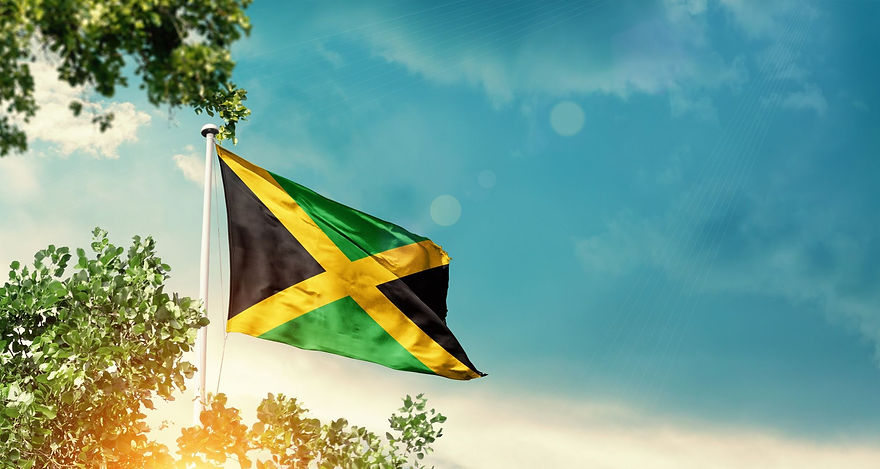


Honouring Jamaica's Prime Ministers
The exhibition offers a concise overview of each Prime Minister's tenure, highlighting key milestones, notable policies, and individual contributions to Jamaica's nation-building efforts.
It aims to be accessible, informative, and engaging for a general audience, fostering a deeper understanding of Jamaica's post-independence leadership and its impact on the country's trajectory.


PBCJ's QR Code Project
The Public Broadcasting Corporation of Jamaica (PBCJ), as the sole public service broadcaster in Jamaica, holds a unique responsibility to protect, preserve and promote the nation’s authentic cultural values, history, and collective memory. PBCJ serves as the custodian of Jamaica’s cultural mores, ensuring that the stories, traditions, and significant moments of the nation’s past are preserved, protected, documented, shared, and celebrated for current and future generations.
This project seeks to enhance PBCJ’s existing audio-visual library and exhibition spaces by integrating Quick-Response (QR) codes into pictures, artefacts and written articles curated for the PBCJ’s observance of 100 years of Jamaica’s audio-visual history. These QR codes allow visitors to engage interactively with our exhibits, linking to rich digital content such as videos, audio recordings and detailed written materials that provide deeper insights into Jamaica’s cultural heritage. This integration ensures that historical audio-visual content is preserved in a digital format, making it more accessible and easier to manage.
Incorporating QR codes and digitising analogue materials aligns with PBCJ’s mission to preserve and share Jamaica’s heritage while positioning the organisation as a leader in the use of technology for cultural preservation. PBCJ upholds its role as a forward-thinking institution that seamlessly blends tradition with innovation. This enhanced exhibition offers an interactive, mobile-friendly way for visitors like you to connect with the cultural history of Jamaica, making the past more accessible and engaging than ever before.

Preserving Heritage: The Vital Role of Audiovisual Collections at the PBCJ
The audio-visual collections at the Public Broadcasting Corporation of Jamaica (PBCJ) help to preserve and promote Jamaica’s culture and collective memory.
These collections serve as vital archives, capturing significant historical events, local traditions and the evolution of societal values over time.
By documenting diverse voices and narratives, they foster a sense of identity and continuity, enabling future generations to connect with their heritage.
Additionally, these materials enhance cultural appreciation and understanding, facilitating dialogue among different communities.
Ultimately, audiovisual collections are essential for historical record-keeping, enriching cultural landscapes and promoting national pride.

Pioneering Visionaries: The Legacy of Jamaica's First Television Station
This exhibition honours the groundbreaking team behind Jamaica's first television station, the Jamaica Broadcasting Corporation (JBC).
The team not only transformed broadcasting but also shaped the nation's identity. Through innovative programming and a commitment to local culture, these news anchors, reporters, presenters, editors and managers set the standard for quality television.
They provided a platform for important national discussions, fostered unity, and celebrated Jamaica's rich heritage. Their work continues to influence new generations of broadcasters and remains a vital part of Jamaica's cultural legacy.
Join us in recognising their significant contributions to nation-building and the enduring impact of their pioneering vision.
1951 Cinematic Chronicles: The Jamaica Film Unit and Our Visual Heritage
The Jamaica Film (1951 - 1961) was a division of Britain's Colonial Film Unit. It played a pivotal role in shaping Jamaica’s audiovisual landscape during a transformative era. With the goal of promoting public awareness, the Film Unit produced a diverse range of documentaries, educational films, and promotional content that reflected the social, cultural, and political realities of Jamaica. The Unit had a mobile cinema which brought electricity to some rural areas for the first time.
In its early years, the Film Unit focused on documenting significant national events, government initiatives, and cultural celebrations. These films were not just informational; they captured the spirit of a newly independent nation eager to express its unique identity. The unit also played a crucial role in highlighting issues such as education, health, and social justice, effectively using film as a medium to engage and educate the public.
The Jamaica Film Unit's productions were broadcast nationally, making them accessible to a wide audience. They became a vital part of the Jamaican educational system and were utilised in schools to foster a greater understanding of Jamaican history and culture. Notable films from this period showcased the island's rich traditions, vibrant festivals, and the resilience of its people.
Today, the legacy of the Jamaica Film Unit endures. The impact of its work can be seen in contemporary Jamaican cinema and media, where filmmakers draw inspiration from the rich archive of stories and images created by the Film Unit. We invite you to reflect on the powerful role of the Jamaica Film Unit in documenting our past and shaping our collective identity, celebrating the richness of Jamaica’s audiovisual heritage.

Voices of Innovation & Excellence: Celebrating 65 Years of Radio and Television Excellence
The Public Broadcasting Corporation of Jamaica (PBCJ) invites you to explore our captivating exhibition that honours the dedicated men and women of the Jamaica Broadcasting Corporation (JBC) who helped to shape the radio and television landscape over the past six decades.
This immersive experience highlights not only the General Managers, presenters, and on-air announcers but also the unsung heroes behind the scenes: camera crews, producers, technicians and support staff.
Through a rich collection of photographs and artefacts, visitors will gain insight into the collaborative spirit and innovative techniques that defined Jamaica’s broadcasting journey. From the early days of radio to the digital age of television, this exhibition showcases the evolution of media and celebrates the diverse talents of the men and women who have contributed to our legacy.

A Piece of History on the Audiovisual Landscape: The Unsung Heroes of the JBC
The exhibition celebrates the vital contributions of film and television production crews to the Jamaica Broadcasting Corporation’s (JBC) legacy of storytelling.
These dedicated professionals, including directors, film and camera operators, sound engineers, set designers, makeup artists and producers, brought scripts to life, shaping the narratives that captivated Jamaican audiences at home and abroad.
Their collaborative efforts ensured the highest production standards were upheld, enabling the JBC to deliver diverse and innovative content.
The PBCJ’s exhibition honours the creativity, skill and teamwork that defined the JBC’s enduring impact on Jamaica’s media landscape.
The PBCJ salutes these unsung heroes who made every broadcast possible. Thank you for your service.
A Piece of History on the Audiovisual Landscape: JBC TV Guide
Television has long been a significant part of modern life, shaping culture, entertainment, and consumer habits.
In the 1960s, one of the vital avenues through which TV audiences accessed programming information was the TV guide. The Jamaica Broadcasting Corporation (JBC) TV guide served not only as a scheduling tool but also as a rich historical document.
It provides a fascinating window into the past, revealing much about consumer habits, technological advancement, and cultural shifts. As society continues to evolve, these historical advertisements offer valuable insights into how the media reflects and shapes public consciousness. Through these ads, we understand the social fabric of 1960s Jamaica and the larger trends that defined the era.
TV guides emerge not merely as a programming schedule but as an essential historical document illuminating the intersection of media, culture and commerce.

A Piece of History on the Audiovisual Landscape: Audiovisual Promotion of Linguistic Freedom & Language Pride
The Jamaica Broadcasting Corporation’s (JBC) positively impacted linguistic freedom in Jamaica by promoting the use of the Jamaican language (Patios) through programmes and music videos that authentically reflected Jamaican culture and language.
TV dramas such as Lime Tree Lane and Oliver At Large serve as prime examples of the commitment to showcasing Jamaican culture and language. In addition to entertaining, these shows also validated the everyday experiences and linguistic expressions of Jamaicans.
By infusing patios into mainstream programming, JBC helped to challenge the stigma often associated with the language and promoted it as a legitimate and vibrant mode of communication.
JBC also utilised music videos as an effective means of conveying local culture and language.
The videos featured popular Jamaican artistes whose music was imbued with Patios lyrics, allowing for a unique fusion of visual art and linguistic expression. This approach entertains and educates viewers about the richness of Jamaican culture, further reinforcing the idea that Patios is a valuable and expressive language.
By normalising its use in media. JBC encouraged Jamaicans to embrace their linguistic heritage and challenge the perception that Patois is inferior to English, a key factor in empowering individuals and communities to value their identity and cultural history. As Jamaica continues to navigate its cultural landscape, the role of media in shaping language perceptions remains more important than ever.

A Piece of History on the Audiovisual Landscape: JBC Strikers - Sit Down Demonstration (1964)
In 1964, the Jamaica Broadcasting Corporation (JBC) experienced a pivotal moment in labour history when workers initiated a strike characterised by a sit-down demonstration in Half-Way Tree Square, effectively blocking traffic.
Accusations of JBC journalists reportedly favouring the previous PNP government led to the dramatic protest, which drew significant attention, halting vehicular movement and attracting a crowd of onlookers.
The JBC, as the national broadcaster, played a crucial role in shaping public discourse, making the issues surrounding its workforce particularly significant.

Media Dismissed: The 1981 Jamaica Broadcasting Corporation Dismissals
In 1981, a pivotal moment unfolded in Jamaica's media landscape when thirteen journalists from the Jamaica Broadcasting Corporation (JBC) were dismissed and accused of political bias.
Their courageous fight for justice culminated in a landmark legal victory against the JBC, affirming the vital importance of press freedom and labour rights. The legal firm Rattray Patterson Rattray emerged as a key player in this high-profile case.
'Media Dismissed' celebrates the resilience of those who stood up for their rights, highlighting the enduring impact of their struggle on Jamaica's democratic fabric and the ongoing fight for freedom of expression.